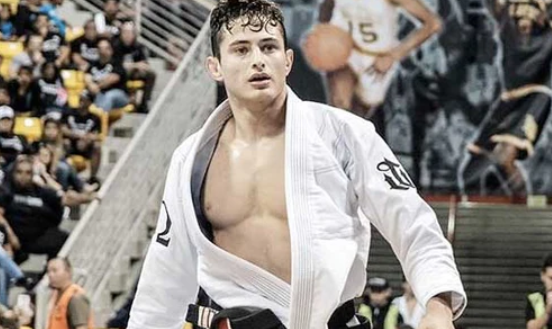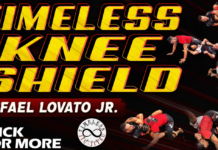
If you are looking for a powerful and unexpected submission from the de la riva guard, you need to learn the Caio Terra ankle lock. This technique is named after Caio Terra, one of the most accomplished Brazilian Jiu-Jitsu competitors and world champions in history.
In this article, we will show you how to set up, finish, sweep, and defend the Caio Terra ankle lock from the De la Riva position. The move is unexpected and highly effective, legal at all levels, and offers a different way of finishing ankle locks compared to the standard Ashi Garami game. By the end of this article, you will be able to easily add this technique to your game and catch your opponents off guard.
Who Is Caio Terra?
Born in 1986 in Rio de Janeiro, Brazil, Caio Terra started training BJJ in 2003 at his mother’s behest, as he was physically smaller than his peers and needed to learn self-defense. He fell in love with the sport after winning silver in his first-ever competition as a blue belt, representing Rodrigo Medeiros’ famous Fight Zone Academy in Copacabana (which he later substituted with the Strauch Academy).
Terra earned his black belt in 2006, flying through the colored belts in only three years of dedicated training, from coaches Reyson Gracie and Paulo Strauch. This was one of the quickest promotions to black belt ever recorded in BJJ history.
From there, he went on to become a record times world champion and one of the greatest of all time, especially in the lower-weight divisions, famous in the community for his passion and bravery.
Caio Terra is known for his maxim “Technique Conquers All”, which he has proven by winning numerous titles in different weight divisions and even in the open weight division. He won the IBJJF World No-Gi Championship ten times (the only grappler to do so) and also has two IBJJF World Championship titles with the Gi. In addition to his main achievements, he has also won several IBJJF Pan American championship, European and American National championships titles.
Cesar Gracie gave Terra the chance to start teaching in the US, which Caio grabbed, eventually building a BJJ empire of his own.
Professor Caio Terra now teaches at his own Caio Terra academy, which is the headquarters for a worldwide network of Jiu-Jitsu schools associated with the program, his one team philosophy and BJJ curriculum through his Caio Terra Association (CTA).
Caio Terra developed his signature ankle lock from the De la Riva guard, which he used to surprise and submit many opponents in high-level competitions. He also created several transitions and variations from this position, making it a versatile and effective weapon in his arsenal.
Setting up the Caio Terra Ankle Lock
The first step to master the Caio Terra ankle lock is to develop a solid De la Riva guard. Then, you can focus on learning how to enter the position from the guard.
The De la Riva guard is a common open guard in BJJ, where you wrap one of your legs around your opponent’s leg and hook your foot behind their knee. You also control their near ankle with your hand and place your other foot on their far hip. The guard is one of the fundamentals in terms of outside guards (since none of your legs end up in between the opponent’s legs) which is usually not associated with leg-locking success.
However, Terra’s ankle lock proves that the inside position does not always matter in the pursuit of ankle locks. To set up the Caio Terra ankle lock from here, you should follow these steps:
- Turn to face your opponent directly. This may seem counterintuitive, as you usually want to be at an angle when playing De la Riva guard. However, this is necessary to get closer to their ankle and create the right leverage for the submission.
- Scoot closer to their ankle with your hips. You want to be as close as possible to your foot with your butt, so you can reach it with your arm without extending too much.
- Get a standard ankle lock grip with your arm. This means wrapping your arm around their foot, with your wrist bone on their Achilles tendon. You also want to grab your own forearm with your other hand and keep your elbow tight to your body.
- Switch your De la Riva hook (outside leg) to their far leg. Instead of hooking behind their knee with your leg, you want to hook behind their ankle or calf. This will help you control their leg and prevent them from stepping out of your guard.
- Bring your other leg over their knee. You want to place your shin across their thigh, just above their knee. This will create a wedge that will stop them from moving forward or backward.
Finishing the Caio Terra ankle lock
Once you have entered the position correctly, you are ready to finish the Caio Terra ankle lock at will. To do so, you need to apply pressure to the ankle joint by extending your hips, arching your back and curling your wrist.
Let’s break it down in steps :
- Extend your hips forward. You want to drive your hips towards their foot, creating a strong base and leverage for the submission.
- Arch your back slightly. You want to lift your chest up a bit, creating more space for your arm and wrist to move.
- Curl your wrist down. You want to twist your wrist towards their toes, creating more pressure on their Achilles tendon.
- Squeeze everything together. You want to keep everything tight and compact, squeezing your knees together, tucking your chin down and pulling their foot towards you.
And here is a video that demonstrates how to finish the Caio Terra ankle lock from the De la Riva guard:
Sweeping from the Caio Terra Ankle Lock Position
Sometimes, your opponent may defend or resist the Caio Terra ankle lock by trying to stand up or balance themselves on their free leg. In this case, you can progress toward using the position as a sweep instead of a submission, since getting the right angle for a leg lock can be very difficult.
There are two ways you can sweep them from here:
- Use your De la Riva hook to elevate their leg and roll them over. You can use your hook behind their far ankle or calf to lift their leg up in the air, making them lose their balance. Then you can roll them over towards their lifted leg side, landing on top of them in side control or mount.
- Switch to a single leg X or X guard position and sweep them to the mat from there. You can also use your hook behind their far ankle or calf to pull their leg towards you, making them step forward with their free leg. Then you can switch your grip from their foot to their knee or thigh, and bring both of your legs inside theirs. From there, you can enter a single leg X or X guard position, where you have many options to sweep them.
Both methods work perfectly and they also connect with each other, offering a closed system revolving around the original ankle locks attack.
Defending the Caio Terra Ankle Lock
Of course, if you want to master the Caio Terra ankle lock, you also need to know how to defend it just in case someone tries it on you, or more importantly to prevent people from escaping and cancel their defensive efforts.
Here are some of the common ways that your opponent can try to escape or counter the position, and how you can prevent or counter them:
- Stuffing your leg: Your opponent may try to push down on your leg that is over their knee, trying to free their leg from your wedge. To prevent this, you need to keep your shin tight against their thigh, using your foot as a hook behind their hip or butt.
- Peeling your grip: Your opponent may try to peel off your grip on their foot by grabbing your fingers or wrist with their hands. To prevent this, you need to keep your elbow close to your body and tuck your chin down over your hands.
- Spinning out: Your opponent may try to spin out of your guard by turning away from you and rolling over their shoulder. To prevent this, you need to keep control of their far leg with your de la riva hook or switch it back behind their knee if they manage to free it.
- Attacking your legs: Your opponent may try to attack one of your legs with a heel hook or toe hold by grabbing it with their free hand or using their free leg as a lever. To prevent this, you need to keep both of your feet active and mobile, using them as hooks or frames against their body.
Conclusion
The Caio Terra ankle lock is a powerful and unexpected submission from the de la riva guard that can surprise and submit many opponents in high-level competitions. It was developed by Caio Terra, one of the most accomplished Brazilian Jiu-Jitsu competitors and world champions in history.
The goal to day was to provide instruction on how to set up, finish, sweep and defend the Caio Terra ankle lock from the De la Riva position.
If you want to train the Caio Terra ankle lock in the gym during class, make sure you practice it with a partner/student who knows how to tap and give them time to do so, as the submission comes on quickly without a warning sign since the setup is very unexpected.
We hope you enjoyed this article and learned something new from it. If you want to learn more from Caio Terra, you can check out his online academy or watch some of his matches and isntructinals on YouTube, where he showcases his amazing skills and techniques.
Lachlan Giles Demonstrates the Effectiveness of Musumeci’s Modified Straight Foot Lock
Dean Lister’s Most Lethal Legal Straight Ankle Lock Explained
https://bjj-world.com/achilles-hold-straight-ankle-lock-counters/














































